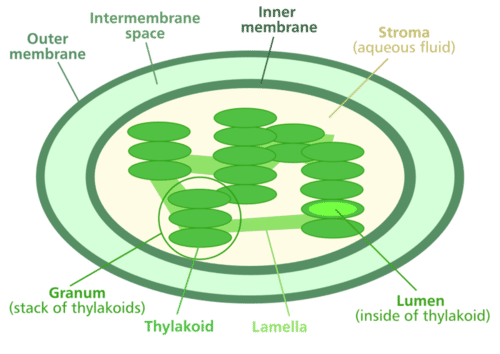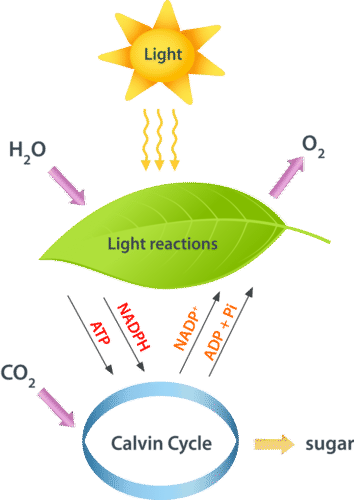2.14光反应
章节大纲
-
Are plants the only organisms that perform photosynthesis?
::植物是唯一进行光合作用的生物吗?Although we generally discuss plants when learning about photosynthesis, keep in mind that plants are not the only organisms that can make their own food. Some bacteria and some protists , such as the pictured here, also perform photosynthesis. This alga has chloroplasts and photosynthesizes just like a plant.
::尽管我们通常在学习光合作用时讨论植物,但要记住,植物并不是能够自己生产食物的唯一生物。 一些细菌和一些原生生物,比如这里的图片,也进行光合作用。 这个藻类有氯白板和光合作用大小,就像植物一样。The Process of Photosynthesis
::相光合成过程In the Presence of Sunlight, Carbon Dioxide + Water → Glucose + Oxygen
::在阳光下,二氧化碳 + 水 甘甘糖 + 氧Photosynthesis takes place in the of the plant cell known as the chloroplasts. Chloroplasts are one of the main differences between plant and animal cells. Animal cells do not have chloroplasts, so they cannot photosynthesize. Photosynthesis occurs in two stages. During the first stage, the energy from sunlight is absorbed by the chloroplast. Water is used, and oxygen is produced during this part of the process. During the second stage, carbon dioxide is used, and glucose is produced.
::光合作用在称为氯板的植物细胞中。氯是植物和动物细胞的主要差异之一。动物细胞没有氯板,因此不能光合作用。光合作用分两个阶段。在第一阶段,阳光的能量由叶板吸收。水使用,氧在工艺的这一部分生产。在第二阶段,使用二氧化碳,并生产甘蔗。Chloroplasts contain stacks of thylakoids , which are flattened sacs of membrane. Energy from sunlight is absorbed by the pigment chlorophyll in the thylakoid membrane . There are two separate parts of a chloroplast: the space inside the chloroplast itself, and the space inside the thylakoids ( Figure ).
::氯甲醚含有一堆甲状腺,它们是薄膜的平坦岩层。光线产生的能量被甲状腺膜中的色素叶素吸收。氯甲状腺中有两个单独的部分:氯甲状腺内的空间和甲状腺内的空间(图 )。- The inner compartments inside the thylakoids are called the thylakoid space (or lumen). This is the site of the first part of photosynthesis.
::甲状腺内的内隔间被称为甲状腺空间(或光合作用),这是光合作用第一部分的场地。
- The interior space that surrounds the thylakoids is filled with a fluid called stroma . This is where carbon dioxide is used to produce glucose, the second part of photosynthesis.
::环绕着甲状腺的内地空间里装满了一种流体,叫做斯托马。这就是二氧化碳用来生产葡萄糖的地方,即光合作用的第二部分。
The chloroplast is the photosynthesis factory of the plant. The Reactants
::复发剂What goes into the plant cell to start photosynthesis? The reactants of photosynthesis are carbon dioxide and water. These are the molecules necessary to begin the process. But one more item is necessary, and that is sunlight. All three components, carbon dioxide, water, and the sun's energy are necessary for photosynthesis to occur. These three components must meet in the chloroplast of the leaf cell for photosynthesis to occur. How do these three components get to the cells in the leaf?
::植物细胞中什么可以开始光合作用?光合作用反应器是二氧化碳和水。 这些是开始过程所必需的分子。 但是,还有一个东西是必需的, 那就是阳光。 光合作用需要所有三个组成部分, 二氧化碳,水和太阳的能量。 这三个组成部分必须在叶细胞的叶片中相遇, 才能发生光合作用。 这三个组成部分如何到达叶片中的细胞呢 ?- Chlorophyll is the green pigment in leaves that captures energy from the sun. Chlorophyll molecules are located in the thylakoid membranes inside chloroplasts.
::叶片中的绿色色素是叶子中的绿色色素,从太阳中捕捉能量。 叶片中的叶子分子位于叶片中的甲状腺膜中。
- The veins in a plant carry water from the roots to the leaves.
::植物的静脉将水从根到叶子。
- Carbon dioxide enters the leaf from the air through special openings called stomata ( Figure ).
::二氧化碳通过称为stomata(图)的特殊开口从空气中进入叶子。
Stomata are special pores that allow gasses to enter and exit the leaf. The Products
::产品What is produced by the plant cell during photosynthesis? The products of photosynthesis are glucose and oxygen. This means they are produced at the end of photosynthesis. Glucose , the food of plants, can be used to store energy in the form of large carbohydrate molecules. Glucose is a simple sugar molecule which can be combined with other glucose molecules to form large carbohydrates, such as starch . Oxygen is a waste product of photosynthesis. It is released into the atmosphere through the stomata. As you know, animals need oxygen to live. Without photosynthetic organisms like plants, there would not be enough oxygen in the atmosphere for animals to survive.
::植物细胞在光合作用期间产生什么?光合作用的产品是葡萄糖和氧。这意味着这些产品是在光合作用结束时生产的。植物的食物甘蔗糖可以用大型碳水化合物分子的形式储存能量。甘蔗糖是一种简单的糖分子,可与其他葡萄糖分子结合形成大型碳水化合物,如淀粉。氧是光合作用废物的产物。通过烟雾释放到大气中。如你所知,动物需要氧来生存。没有植物等光合作用生物,大气中将没有足够的氧供动物生存。The Chemical Reaction
::化学反应The overall chemical reaction for photosynthesis is 6 molecules of carbon dioxide (CO 2 ) and 6 molecules of water (H 2 O), with the addition of solar energy . This produces 1 molecule of glucose (C 6 H 12 O 6 ) and 6 molecules of oxygen (O 2 ). Using chemical symbols, the equation is represented as follows: 6CO 2 + 6H 2 O → C 6 H 12 O 6 + 6O 2 . Though this equation may not seem that complicated, photosynthesis is a series of chemical reactions divided into two stages, the and the Calvin cycle ( Figure ).
::光合作用的总体化学反应是二氧化碳(CO2)的6个分子和水(H2O)的6个分子,加上太阳能,产生1个葡萄糖(C6H12O6)的分子和氧(O2)的6个分子。 使用化学符号,该等式的表示如下:6CO2 + 6H2O C6H12O6+ 6O2. 虽然这个等式似乎并不复杂,但光合作用是一系列化学反应,分为两个阶段,即卡尔文周期和卡尔文周期(图)。The Light Reactions
::轻光反应Photosynthesis begins with the light reactions. It is during these reactions that the energy from sunlight is absorbed by the pigment chlorophyll in the thylakoid membranes of the chloroplast. The energy is then temporarily transferred to two molecules, ATP and NADPH , which are used in the second stage of photosynthesis. ATP and NADPH are generated by two electron transport chains . During the light reactions, water is used and oxygen is produced. These reactions can only occur during daylight as the process needs sunlight to begin.
::光合作用以光反应为开端。 正是在这些反应中,阳光的能量被叶牌胸膜中的色素叶绿素吸收。然后将能量暂时转移到两个分子ATP和NADPH,这两个分子在光合作用第二阶段使用。ATP和NADPH是由两个电子运输链生成的。在光反应中,水被使用,氧被产生。这些反应只能在白天发生,因为过程需要阳光才能开始。The Calvin Cycle
::卡尔文周期The second stage of photosynthesis is the production of glucose from carbon dioxide. This process occurs in a continuous cycle, named after its discoverer, Melvin Calvin. The Calvin cycle uses CO 2 and the energy temporarily stored in ATP and NADPH to make the sugar glucose.
::光合作用的第二阶段是用二氧化碳生产甘蔗糖。这一过程在连续周期中发生,以发现者Melvin Calvin命名。 卡尔文周期使用二氧化碳和暂时储存在ATP和NADPH的能源制造甘蔗。Photosynthesis is a two stage process. As is depicted here, the energy from sunlight is needed to start photosynthesis. The initial stage is called the light reactions as they occur only in the presence of light. During these initial reactions, water is used and oxygen is released. The energy from sunlight is converted into a small amount of ATP and an energy carrier called NADPH. Together with carbon dioxide, these are used to make glucose (sugar) through a process called the Calvin Cycle. NADP+ and ADP (and Pi, inorganic phosphate) are regenerated to complete the process. Summary
::摘要- Photosynthesis occurs in the chloroplast of the plant cell.
::工厂电池的叶绿板中出现光合作用。
- Carbon dioxide, water, and the sun's energy are necessary for the chemical reactions of photosynthesis.
::二氧化碳、水和太阳的能量 是光合作用化学反应所必须的
- The products of photosynthesis are glucose and oxygen.
::光合作用的产品是葡萄糖和氧气。
Explore More
::探索更多Use the resources below to answer the following questions.
::利用以下资源回答下列问题。Explore More I
::探索更多- Photosynthesis at (7:08)
::7:08时的光合作用
- How do autotrophs differ from heterotrophs? How are they the same?
::自发与血化有何不同?它们如何相同?
- What do plants do with most of the sugar they produce during photosynthesis?
::植物在光合作用期间 如何处理大部分糖?
- How do decreasing levels of CO 2 affect plants? How do you think increasing levels of CO 2 affect plants?
::二氧化碳的减少水平如何影响植物? 你认为二氧化碳的增加水平如何影响植物?
Explore More II
::探索更多情况二- Photosynthesis at (3:03)
::3:03时的光合作用
- What are the three main limiting factors that affect the rate of photosynthesis?
::影响光合作用率的三个主要限制因素是什么?
- When a plant spreads out its leaves, which main limiting factor is maximized? Why?
::当植物叶子散落的时候,什么主要的限制因素是最大化的?为什么?
- Where do the chemical reactions of photosynthesis take place?
::光合作用化学反应在哪里发生?
Review
::回顾- Describe the structures of the chloroplast where photosynthesis takes place.
::描述发生光合作用的地方的叶绿板结构。
- What would happen if the stomata of a plant leaf were glued shut? Would that plant be able to perform photosynthesis? Why or why not?
::如果植物叶的石膏被粘上,将会发生什么情况?该植物能否进行光合作用?为什么或为什么不能呢?
- What are the reactants needed to perform photosynthesis? The products?
::反应器需要什么来进行光合作用?
- What happens to the products of photosynthesis?
::光合作用的产品呢?
- The inner compartments inside the thylakoids are called the thylakoid space (or lumen). This is the site of the first part of photosynthesis.



